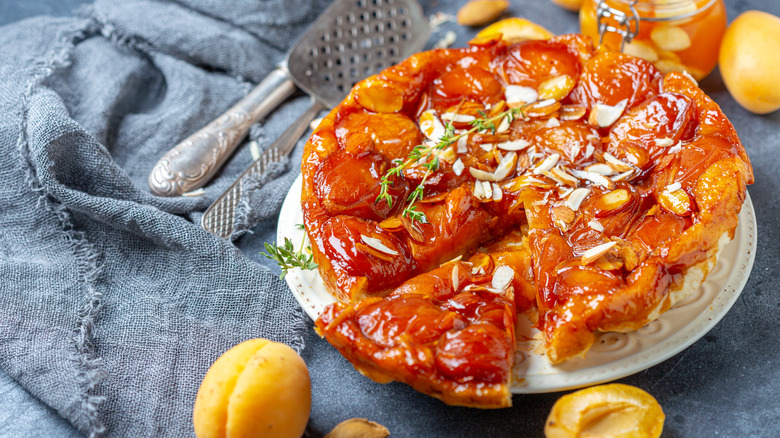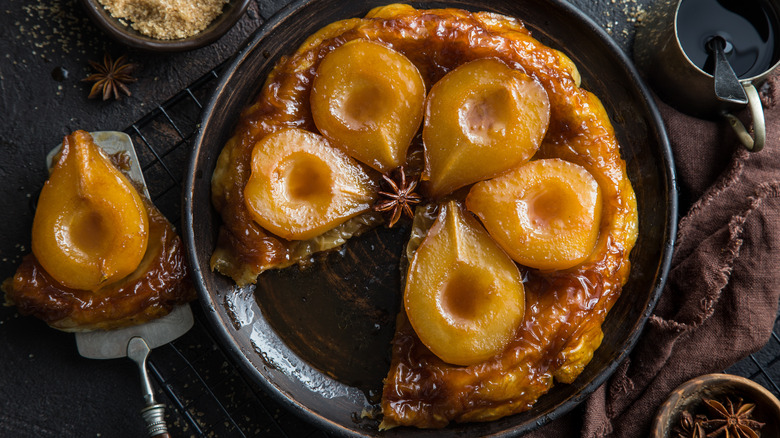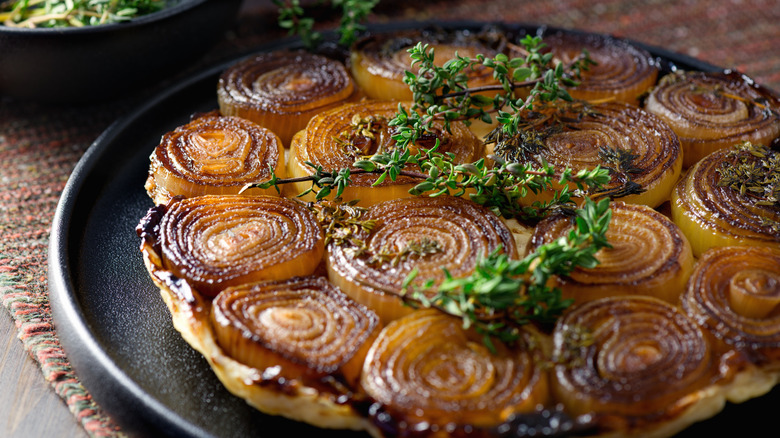Make Tarts Upside Down For Extra-Caramelized Toppings
Store-bought puff pastry is already a gift to home cooks looking for an easy dinner or dessert, but somehow, TikTok has found a way to make this freezer staple even more versatile and easy to use. Upside-down tarts have become ubiquitous on the platform, taking a classic baking technique and bringing it to the masses. Many users have shown viewers just how easy it is to make a beautiful, delicious tart that looks like you spent hours on it in a short amount of time.
@lilyghodrati Caramelised Honey & Nectarine pastries 🍯 #honey #nectarine #pastry #pastries #patisserie #puffpastry #caramelised #bake #baking #sweet #snack #foodhack #EasyRecipe #Recipe #eats #food #FoodTok #Foodie #fy #fyp #foryou #foryoupage
To make your own upside-down tart — first, you'll want to make sure you're buying all-butter frozen puff pastry. (It tastes better and makes for fluffier layers.) Then, all you need to do is arrange a piece of fruit, vegetable, meat, or other topping on a baking sheet, layer it with a slab of puff pastry, seal the edges, and bake it in the oven. You probably want to score the edges, and you may want to add an egg wash, but your end result will be a delicious tart with caramelized toppings.
Why make a tart upside down?
One of the trickiest parts about baking tarts, pies, or other dishes involving pastry with a fruit topping or filling is preventing the crust from getting soggy. (And as any "Great British Bake Off" fans know, a soggy bottom is just about the worst thing that can happen to you when baking — aside from your house catching on fire.) As fruit cooks, it releases liquid, and too much liquid can destroy a fluffy pastry. This is why many fruit pies are blind-baked, with the crust cooked separately before adding in the filling. This technique should also be applied to anything with a liquid center, like custard pie, pumpkin pie, or sugar pie.
In addition to preventing a soggy bottom, baking tarts or pies upside down helps the fruit to caramelize by putting it in close contact with the hot sheet pan. (Though using parchment paper to prevent sticking is a good idea.) If you are adding a sprinkle of sugar or drizzle of olive oil, baking upside down will also make the caramelization more even, by drawing the liquid downwards to fully coat your fruit. This will prevent those burnt edges that sometimes occur when making a standard apple tart or something similar.
Tips for upside down tarts
The upside-down tart isn't a new idea, despite its recent popularity. The most well-known example of this kind of dish is the tarte tatin, a French take on apple pie that is made upside down. There's also the American cousin to the tarte tatin, the apple upside-down pie, which has added pecans.
But though apples make great use of this technique, they're hardly the limit. For sweet tarts, opt for soft, quick-cooking fruits. Stone fruits like peaches, apricots, and plums work well — as do strawberries, pears, or pineapple. You can drizzle honey, olive oil, balsamic vinegar, caramel, or other sauces or seasonings onto your baking sheet before your fruit. Since the aesthetic is part of the appeal, consider using eye-catching ingredients. Starfruit would make beautiful upside-down tarts, perhaps sprinkled with some tajin or shredded coconut. Or perhaps you could cut divots in halved strawberries to make little hearts, topped with whipped cream for a strawberry shortcake riff.
And don't forget savory options! A shallot or onion tart will come off wonderfully, perhaps sprinkled with thyme or a glug of good olive oil. Or try tomato with a bit of goat cheese and whole-grain mustard. You could also par-cook carrots (crème fraîche and feta make for a great carrot accompaniment), or thinly slice zucchini or kabocha squash for an easy, fake-fancy snack.



